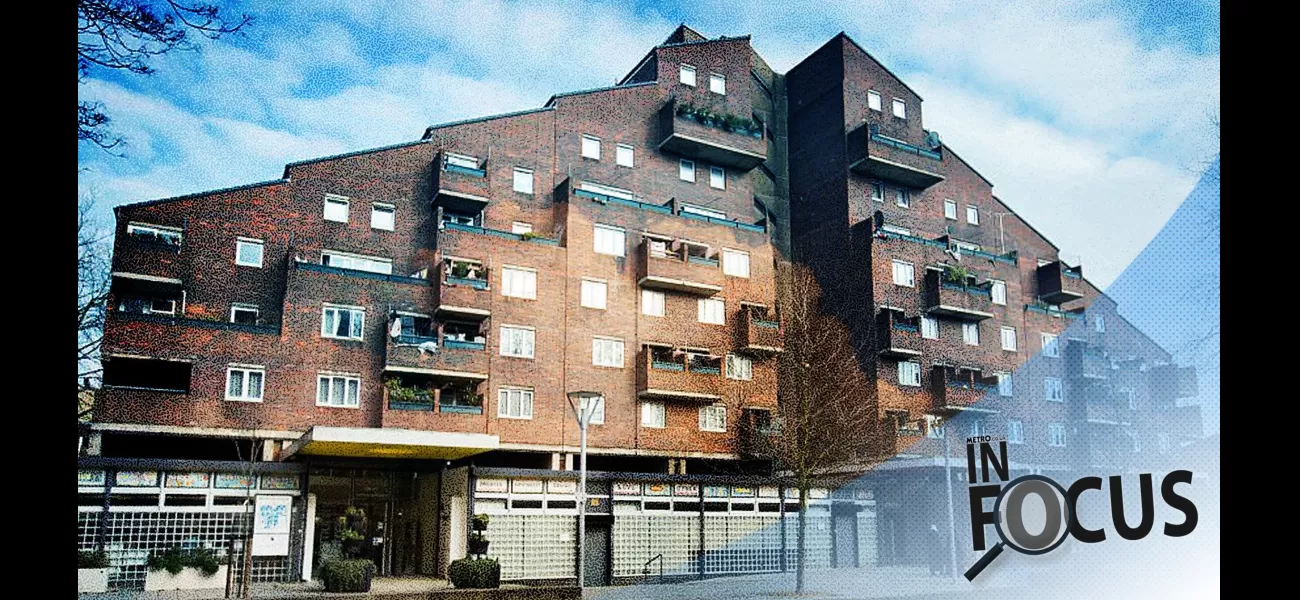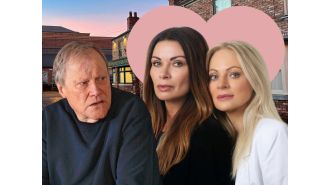The estate was once described as a "dump" by Ann Widdecombe.
Residents working to redefine Andover Estate's image and reputation.
November 11th 2023.

Residents of the Andover Estate in London are determined to break down the negative preconceptions of their home. A network of winding streets make up the estate, which towers over the surrounding area. It's close to homes worth millions, yet the majority of the 1,2, and 3 bedroom flats are council housing.
At the centre of the estate is the iconic 10-storey Dibdin House, with a pyramid design. 15 years ago, the area gained negative attention after MP Ann Widdecombe visited the estate for a documentary. She described it as a ‘dump’ and asked young people why they were wearing hoods. The young man she spoke to explained he felt safer wearing it, and that he wasn't targeting old ladies.
In response to the documentary, a powerful film called ‘Beyond the Hoodie’ was made with the support of young residents, who felt the documentary took things out of context and gave false perceptions. The issues of drugs, crime, and negative behaviour still persist today. But there's much more to the estate than meets the eye.
When the area was first built in the sixties, it was considered 'luxury' after the council cleared post-war slum housing. It featured amenities that were revolutionary at the time, such as indoor toilets. Interviews with 40 people conducted by London Metropolitan University revealed the insight into changing perceptions.
The estate is still a target for county lines gangs, but the young people living within it are determined to create their own narrative. A local youth club was launched to provide a safe space for teenagers, and the lead youth worker Khalil Taipow is determined to be ‘the adult he never had’ to the community.
Reon, a 14 year old living on the estate is all too aware of the prejudices Black teenagers face on a daily basis. ‘People will see a bunch of Black boys living here and think a certain way based on how we look or how we walk,’ he tells The Agency. ‘Sometimes people bunk school and chill in the estate. That’s when they can start going down the wrong path.’
The Andover Estate is a place of contrasts and complex stories. Young people are on a mission to redefine it. A place where the residents can create their own narrative, no matter what preconceptions of their home they’re up against.
Residents of the Andover Estate in London are on a mission to change perceptions of their home. Located in the leafy Finsbury Park area of North London, the estate is a stone’s throw away from houses worth millions, yet it is jammed with 1/2/3 bed flats - the majority of which are council housing. The most famous building of the estate is the 10-storey high Dibdin House, famed for its pyramid design and containing 61 homes.
Despite the estate’s modern reputation, it was considered ‘luxury’ when first built in the sixties, and was part of a scheme to build ‘up’ in order to create more homes. Constructed after the local council cleared post-war slum housing, the estate had three large triangular buildings - Didbin, Noll and Docura Houses - which were christened after regional stations.
Unfortunately, things began to take a turn for the worse when 15 years ago, many young people on the Andover Estate were branded ‘hoodies’ following a visit from MP Ann Widdecombe for a documentary. She lived with locals for three days and compared the estate to a ‘dump’, with a ‘very nasty, very threatening’ atmosphere. In one scene, the former MP asked a young man why his hood was up, to which the young man replied: ‘I wear it to feel safe. I want to scare people who scare me. Not old ladies.’
In response to the controversial documentary, a powerful film called ‘Beyond the Hoodie’ was made with the support of young residents, who felt the documentary took things out of context and gave ‘fake’ perceptions.
Today, people living on the estate still face issues over drugs, crime and negative behaviour. However, there’s far more to the development than meets the eye. Researchers professor John Gabriel, Dr Alya Khan and Gulser Rose Kaya delved into the history of the area and interviewed 40 people to get a true insight into changing perceptions. For the young people living within the estate, it’s simply home.
14-year-old Reon, shielding from heavy rain in the estate’s Community Centre, tells The Agency: ‘I’ve been on the estate for three years now. People will see a bunch of Black boys living here and think a certain way based on how we look or how we walk. If I’m chatting to someone online and they ask where I’m from, they kind of respond “ooh” when I say Andover Estate. Like they’re a bit scared, or something.’
To combat the negative effects of living in such an area, a local youth club was launched last year to ‘bridge a gap’ within youth provision for primary school leavers. Lead youth worker Khalil Taipow, 23, still remembers the struggles he faced growing up in Camden in the early noughties, and is determined to help others. He tells The Agency: ‘I feel I’ve definitely fed into that narrative in the past because I was in and out of trouble growing up. But I beat the odds against me and now do what I can to help others. If I can do it, anyone can.’
The youth club at the Andover Estate Community Centre is a place of sanctuary for kids like Reon, and the young residents of the estate are determined to change their own narrative. With a safe space and people like Khalil to guide them, anything is possible.
At the centre of the estate is the iconic 10-storey Dibdin House, with a pyramid design. 15 years ago, the area gained negative attention after MP Ann Widdecombe visited the estate for a documentary. She described it as a ‘dump’ and asked young people why they were wearing hoods. The young man she spoke to explained he felt safer wearing it, and that he wasn't targeting old ladies.
In response to the documentary, a powerful film called ‘Beyond the Hoodie’ was made with the support of young residents, who felt the documentary took things out of context and gave false perceptions. The issues of drugs, crime, and negative behaviour still persist today. But there's much more to the estate than meets the eye.
When the area was first built in the sixties, it was considered 'luxury' after the council cleared post-war slum housing. It featured amenities that were revolutionary at the time, such as indoor toilets. Interviews with 40 people conducted by London Metropolitan University revealed the insight into changing perceptions.
The estate is still a target for county lines gangs, but the young people living within it are determined to create their own narrative. A local youth club was launched to provide a safe space for teenagers, and the lead youth worker Khalil Taipow is determined to be ‘the adult he never had’ to the community.
Reon, a 14 year old living on the estate is all too aware of the prejudices Black teenagers face on a daily basis. ‘People will see a bunch of Black boys living here and think a certain way based on how we look or how we walk,’ he tells The Agency. ‘Sometimes people bunk school and chill in the estate. That’s when they can start going down the wrong path.’
The Andover Estate is a place of contrasts and complex stories. Young people are on a mission to redefine it. A place where the residents can create their own narrative, no matter what preconceptions of their home they’re up against.
Residents of the Andover Estate in London are on a mission to change perceptions of their home. Located in the leafy Finsbury Park area of North London, the estate is a stone’s throw away from houses worth millions, yet it is jammed with 1/2/3 bed flats - the majority of which are council housing. The most famous building of the estate is the 10-storey high Dibdin House, famed for its pyramid design and containing 61 homes.
Despite the estate’s modern reputation, it was considered ‘luxury’ when first built in the sixties, and was part of a scheme to build ‘up’ in order to create more homes. Constructed after the local council cleared post-war slum housing, the estate had three large triangular buildings - Didbin, Noll and Docura Houses - which were christened after regional stations.
Unfortunately, things began to take a turn for the worse when 15 years ago, many young people on the Andover Estate were branded ‘hoodies’ following a visit from MP Ann Widdecombe for a documentary. She lived with locals for three days and compared the estate to a ‘dump’, with a ‘very nasty, very threatening’ atmosphere. In one scene, the former MP asked a young man why his hood was up, to which the young man replied: ‘I wear it to feel safe. I want to scare people who scare me. Not old ladies.’
In response to the controversial documentary, a powerful film called ‘Beyond the Hoodie’ was made with the support of young residents, who felt the documentary took things out of context and gave ‘fake’ perceptions.
Today, people living on the estate still face issues over drugs, crime and negative behaviour. However, there’s far more to the development than meets the eye. Researchers professor John Gabriel, Dr Alya Khan and Gulser Rose Kaya delved into the history of the area and interviewed 40 people to get a true insight into changing perceptions. For the young people living within the estate, it’s simply home.
14-year-old Reon, shielding from heavy rain in the estate’s Community Centre, tells The Agency: ‘I’ve been on the estate for three years now. People will see a bunch of Black boys living here and think a certain way based on how we look or how we walk. If I’m chatting to someone online and they ask where I’m from, they kind of respond “ooh” when I say Andover Estate. Like they’re a bit scared, or something.’
To combat the negative effects of living in such an area, a local youth club was launched last year to ‘bridge a gap’ within youth provision for primary school leavers. Lead youth worker Khalil Taipow, 23, still remembers the struggles he faced growing up in Camden in the early noughties, and is determined to help others. He tells The Agency: ‘I feel I’ve definitely fed into that narrative in the past because I was in and out of trouble growing up. But I beat the odds against me and now do what I can to help others. If I can do it, anyone can.’
The youth club at the Andover Estate Community Centre is a place of sanctuary for kids like Reon, and the young residents of the estate are determined to change their own narrative. With a safe space and people like Khalil to guide them, anything is possible.
[This article has been trending online recently and has been generated with AI. Your feed is customized.]
[Generative AI is experimental.]
0
0
Submit Comment





